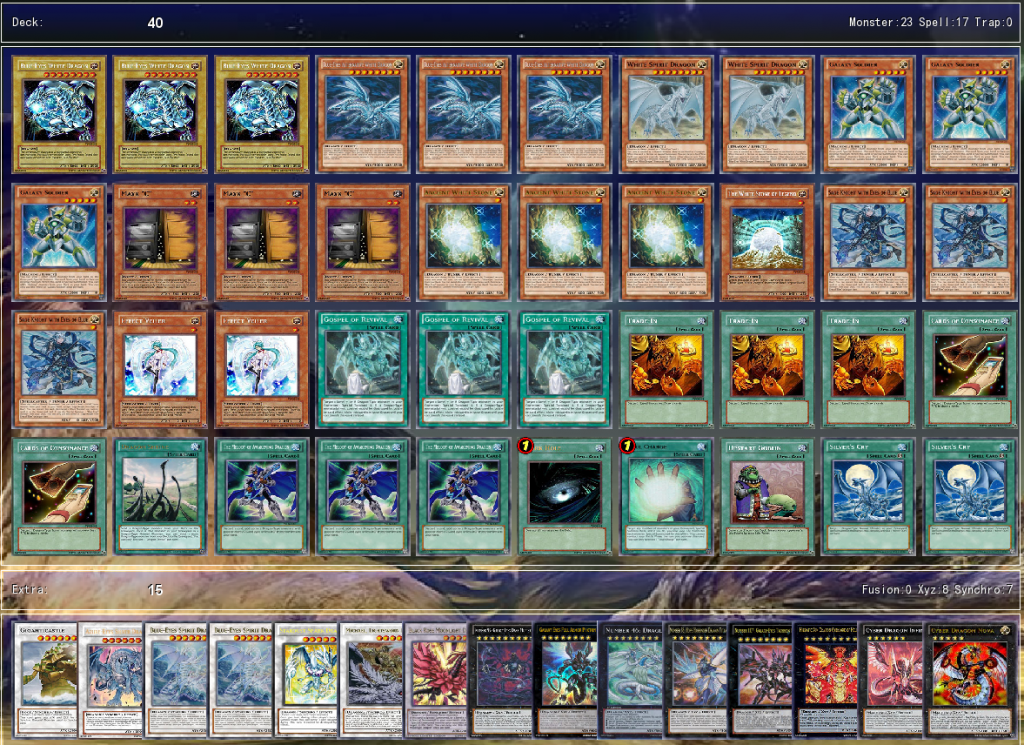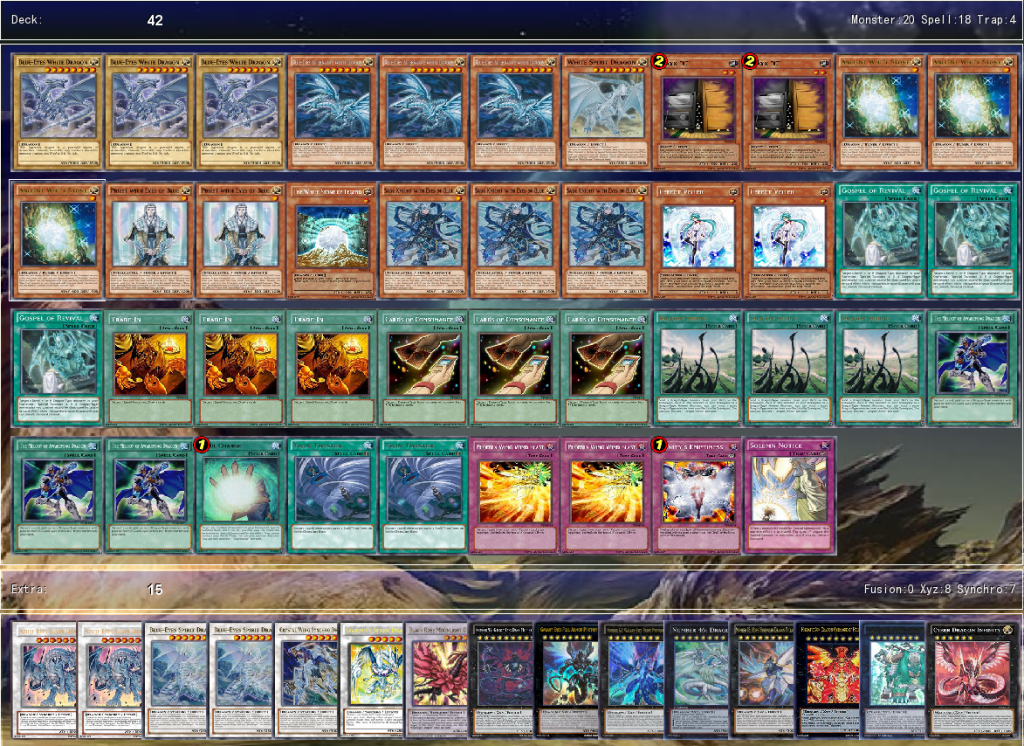The core of each duelist’s decks is largely similar, albeit with one major difference in technical choices. Mathematically speaking, Hiyama’s deck is more consistent. In fact, Hiyama’s Blue-Eyes deck shows mathematical precision, from opening hand success rate, to his choice of a 42-card deck.
The Deck Lists
Erik Christensen's 2016 World Championship Deck

Shunsuke Hiyama's 2016 World Championship Deck

The Combos
The most common two and three card opening plays for most Blue-Eyes builds are as follows:
- Play 1: Special summoning Blue-Eyes Alternative White Dragon by default
- Play 2: Normal summoning a monster, then activating Sage with Eyes of Blue
- Play 3: Activating Melody of Awakening Dragon
- Play 4: Activating Trade-In, then activating Return of the Dragon Lords
Blue-Eyes is an aggressive archetype. Thus, the probabilities shown represent the player going second in a duel. However, it is highly likely Christensen constructed his deck in which it would not matter if he opened first or second. This is due to his tech choices and using a 40-card deck. However, Hiyama uses a 42-card deck, which maintains the same level of consistency as a 40-card deck if the duelist elects to open second here.
| Play | Shunsuke Hiyama (Japan) | Erik Christensen (U.S.A.) |
#1 (Two-Card Combo) | 30% | 19% |
#2 (Two-Card Combo) | 34% | 34% |
#3 (Two-Card Combo) | 34% | 35% |
#4 (Three-Card Combo) | 11% | 20% |
This information illustrates a major difference behind deck building here, as Hiyama’s deck focuses on smaller, two card plays, whereas Christensen doubled down on the three-card trade-in combo. Hiyama’s two card plays have a significantly lower standard deviation than Christensen’s deck. Smaller plays ensure higher opening hand consistency along with more reliable top-decks. This is largely why the Blue-Eyes archetype has a few supporting cards that remain relatively unused.
There are a few standout choices which affect the consistency of both decks. Hiyama’s choosing three copies of Dragon Shrine significantly increases the chance of summoning Blue-Eyes Alternative White Dragon. Furthermore, Dragon Shrine thins out potential dead draws, while enabling a summon during the end phase. Christensen’s addition of Galaxy Soldier introduces a three-card play altogether, introducing a 20% chance of summoning Cyber Dragon Infinity. Additionally, Christensen includes three copies of Silver’s Cry, bolstering the previous three-card play’s percentage over Hiyama.
However, the addition of Galaxy Soldier and the doubling down on revival spells lowers the deck’s overall consistency. All plays and tech choices considered, here is the overall 6-card opening hand consistency once more.
Play | Shunsuke Hiyama (Japan) | Erik Christensen (U.S.A.) |
#1 (Two-Card Combo) | 30% | 19% |
#2 (Two-Card Combo) | 34% | 34% |
#3 (Two-Card Combo) | 34% | 35% |
#4 (Three-Card Combo) | 11% | 20% |
Cyber Dragon Infinity | N/A | 20% |
Total | 65% | 64% |
It is important for deck builders to place consistency as one of their founding elements of a competitive deck. However, sixty-six percent is the magic number duelists should attain when considering the consistency of their opening plays. This is due to duelists are required to take two-thirds of the match in order to win. This number will ensure duelists will have their best chances of winning a match. However, there are two aspects of constructing a deck to ensure consistency. Hiyama comes remarkably close to the 66% target. However, most impressively, his deck is constructed to take advantage of a six-card opening hand, which is the maximum number of cards to account for.
The Expected Hands
Card Classifications
| Name | Initiator | Combo Piece | Disruption | Recovery | Utility |
| Blue-Eyes White Dragon | Yes | ||||
| Blue-Eyes Alternative White Dragon | Yes | ||||
| Dragon Spirit of White | Yes | ||||
| Maxx "C" | Yes | ||||
| Sage with Eyes of Blue | Yes | ||||
| The White Stone of Ancients | Yes | ||||
| The White Stone of Legend | Yes | ||||
| Effect Veiler | Yes | ||||
| Master with Eyes of Blue | Yes | ||||
| Galaxy Soldier | Yes | ||||
| Cards of Consonance | Yes | ||||
| Silver's Cry | Yes | ||||
| Upstart Goblin | Yes | ||||
| Trade-In | Yes | ||||
| The Melody of Awakening Dragon | Yes | ||||
| Dragon Shrine | Yes | ||||
| Return of the Dragon Lords | Yes | ||||
| Soul Charge | Yes | ||||
| Dark Hole | Yes | ||||
| Twin Twisters | Yes | ||||
| Solemn Strike | Yes | ||||
| Phoenix Wing Wind Blast | Yes |
Most Common Opening Hand
Card Type | Shunsuke Hiyama (Japan) | Erik Christensen (U.S.A.) |
Initiator | 1 | 1 |
Combo Piece | 2 | 2 |
Disruption | 1 | 1 |
Recovery | 1 | 1 |
Utility | 1 | 1 |
Total | 6 | 6 |
While deck building, duelists may divide each of their cards into separate pools. In this case, consider five card types: an initiator, combo piece, disruption, recovery, and utility. Hiyama’s opening hand opens up perfectly for a player wanting to open second in a duel. Oddly, Christensen’s hand opens up as if he were to draw six cards as well. Considering Christensen's tech choice of Galaxy Soldier, his strategy involved opening duels first to summon Cyber Dragon Infinity without interruption. However, he is due for more bad hands since his build features more than one card group with an expected value of one. Furthermore, Galaxy Soldier only has a 20% chance of seeing the field. The costs outweighed the benefits for Christensen.
Round One Opening Hands
| Shunsuke Hiyama (Japan) | Erik Christensen (U.S.A.) |
| The White Stone of Ancients | Cards of Consonance |
| The White Stone of Legend | Return of the Dragon Lords |
| Cards of Consonance | Silver's Cry |
| The Melody of Awakening Dragon | Effect Veiler |
| Effect Veiler | Sage with Eyes of Blue |
| Blue-Eyes Alternative White Dragon | N/A |
Conclusion
Both finalists in the 2016 World Championship faced one another with very powerful decks, which had all the markings of a match for the ages. However, Erik Christensen's deck stalled twice in the most important face-off of last year. From a statistical standpoint, Shunsuke Hiyama focused on smaller, more consistent two-card plays, while optimizing his deck for opening duels second. Christesen's plans of opening first in hopes of establishing large and disruptive plays came in direct conflict with how the deck is constructed. Going for the biggest plays possible is always advisable, when deck building. However, it is likely too much consistency was sacrificed in going this route. Nonetheless, both duelists came to the table with excellent decks in a match Seto Kaiba was destined to win.




